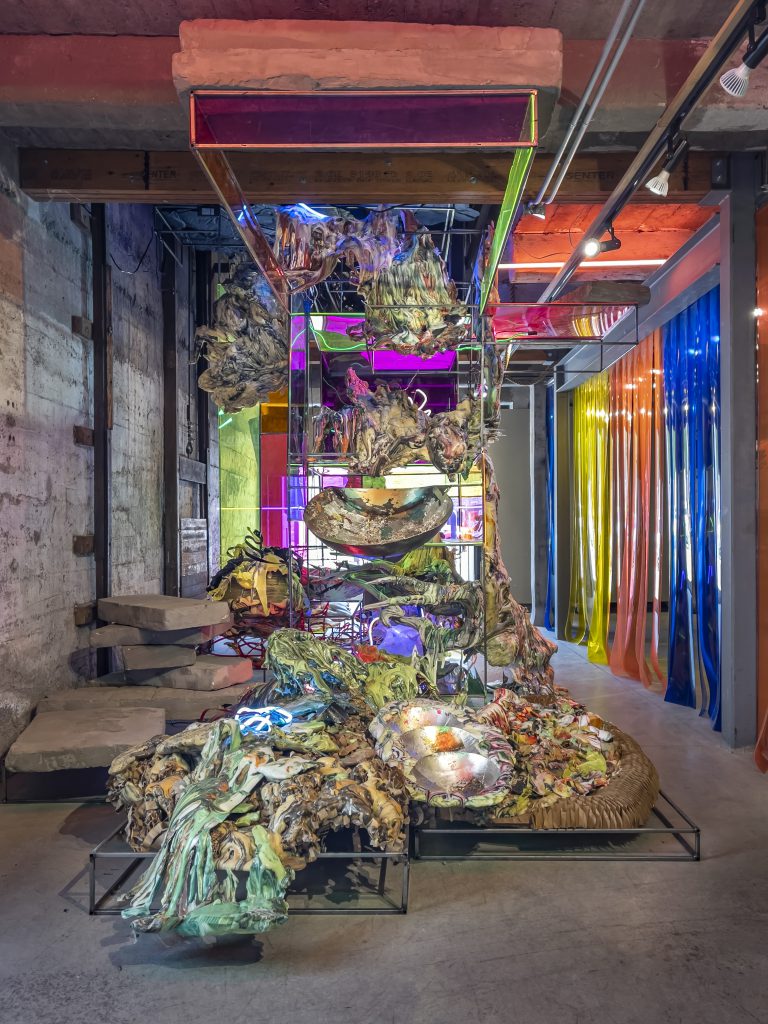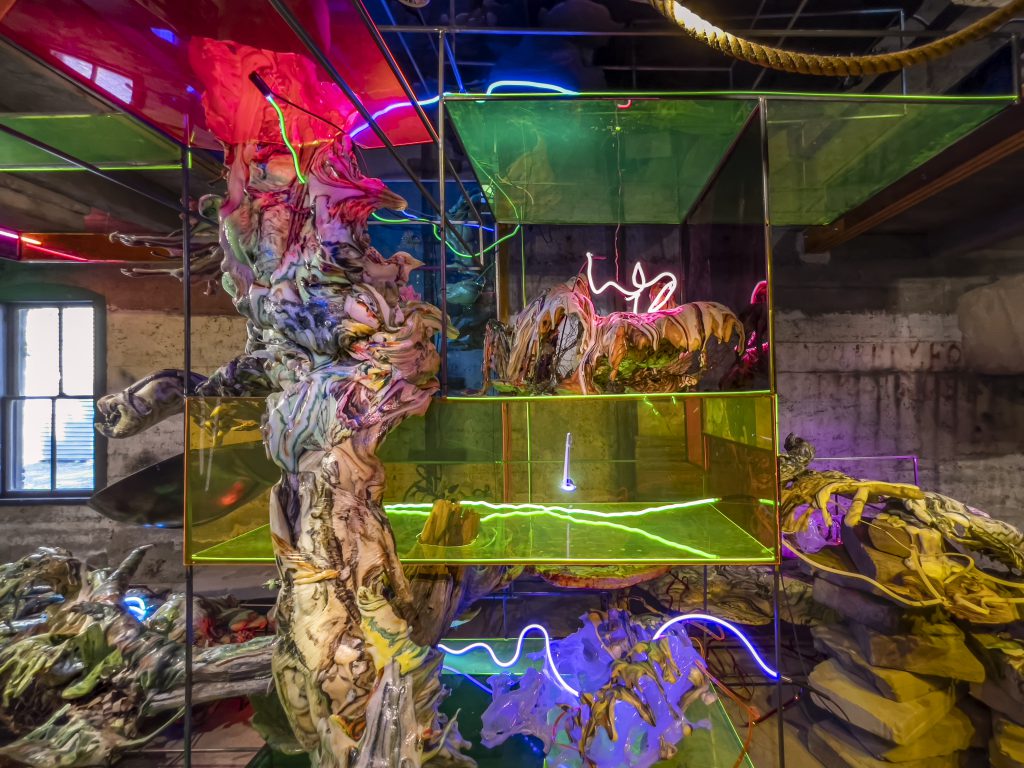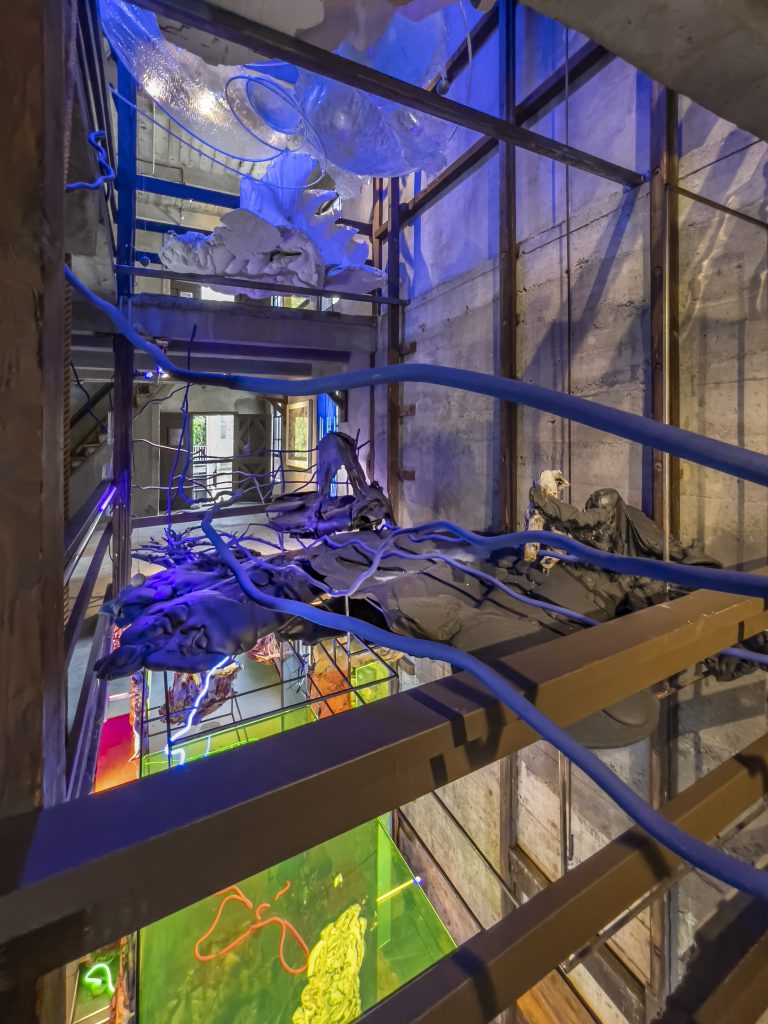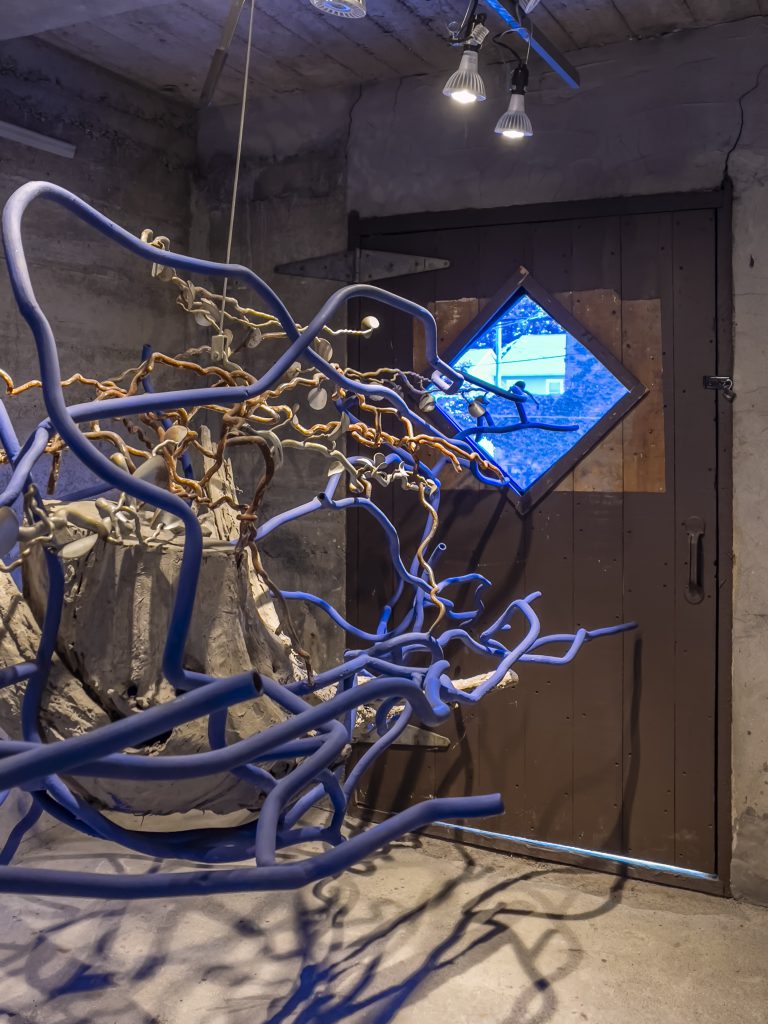
All photos ©Peter Aaron unless otherwise noted.
I was fortunate to visit Judy Pfaff in her studio recently to discuss her exhibition, ar.chae.ol.o.gy, which is currently on view at the Pamela Salisbury Gallery in Hudson, New York, through July 25. The exhibition features an elaborate installation spanning three floors of the gallery’s historic “Carriage House,” as well as an alcove featuring Pfaff’s recent works on paper.
Pfaff is, like her art, a lot of things, and hard to sum up. “My work is scattershot, like a Pachinko game,” she says, “and if things get solid and specific, I get nervous. So, I tend to complicate things because it gives me more options—more ways to look at things. If I think there is one thought, one idea, it doesn’t seem enough for me. Sometimes there are layers into something that I need to get at. So, by adding I can get closer to what I think is essential, but I can’t get there right away.”
Pfaff lives and works not far away, on a former apple orchard in Tivoli, New York, in the mid-Hudson Valley, near Bard College, where she has taught for over two decades. She has a sprawling compound of workspaces, living spaces, and storage areas that are like her sculptures and installations in that they are composed with combinations of various shapes, materials, and colors, all spliced together in unusual configurations. The studio buildings brim with invention, potential, and energy.

Photo ©Liza Todd Tivey.
Her place is an impressive accomplishment—a steady stream of tens of thousands of decisions made manifest, by accretion, into an always unexpected— and marvelous—result. Although the set-up is ergonomic (every tool is in its place), it is also free flowing—the product of an open mind. There is no strict system here, or rules for consistency or expedience. Pfaff’s newest studio is a high-arched building clad with corrugated galvanized steel; she uses this space to bend glass tubing for colorful neon lights, which are central and essential to ar.chae.ol.o.gy’s immersive ambience.
Pfaff’s large sculptures and installations, including ar.chae.ol.o.gy, are epic in scale, and superabundant in their detail and complexity, which can seem wildly untamed and disorienting at first. However, once I examined the way she combines and merges elements, I had a better understanding of how they come together. They evolve fast from one installation to the next, and dramatically change to adapt to every new setting. I also recognized an animated spirit in them—one that is both sentient and charismatic—and capable of possessing a transferable energy.

Pfaff presents her situational sculptures in sections (and sections within sections); they are comprised of moments or zones of abstraction that ultimately coalesce into coherence. They are ingeniously formed and fitted; and the air pockets within them and around them are used to great effect.
I was able to closely observe Pfaff’s process in one of her monumental pieces five years ago, when Pfaff presented a vast installation/exhibition Grasshopper—curated by writer David Ebony—at CR10 [The Frank Institute @ CR10], in the midst of the quiet, farmland countryside of Columbia County, a two-hour drive north of New York City. CR10 is a cinderblock building, 140 feet long. It has a row of large windows set just a few feet apart. Built in early or mid-twentieth century to accommodate some kind of small animal husbandry operation (lab mice, it’s rumored), the building was purchased and repurposed as an arts space by the enterprising artist and polymath Francine Hunter McGivern.
The moment I entered this unusually perspectival interior, I felt the immense presence of Pfaff’s sprawling sculpture, and was awed by how well it became the space. Her colossal creation flowed on and over the old wooden floorboards, and then up and down through the airspace of the two four-by-four-foot openings that connected the two stories.
Grasshopper was a marvel of well-focused ambition that opened with enormous tree stumps suspended in air, their outstretched roots ensnarled in a contortion of writhing metal rods and wires. It was like a gargantuan nervous system that sensitized, enervated, and personified the air mass between the walls.
That choreographed commotion transitioned into a colorful heap of disorderly plastics, which in turn spiraled into mandalas. In the work, Pfaff suggested a trip through time, from the primordial to the present. But there was too much there for me to take in on that one single afternoon.
Since then, I’ve thought a lot about that show, and wished I had stayed longer, or returned to it, because as is the case with all of Pfaff’s site-specific works, when the show closes, it’s gone forever. Certainly, her pieces provide photographers with a limitless opportunity to capture exquisite details, but unfortunately, even the best photographs of her installations fail to evoke the full sensation of the experience.

When I learned of a new Judy Pfaff show coming to Pamela Salisbury’s Gallery in Hudson (a venue where I have shown my own work), I was determined to make time in my life to give ar.chae.ol.o.gy more focused attention. I wanted to better understand how Pfaff’s bounteously abundant compositions are conceived and made, and how meaning springs from her use of a wide range of materials, and the way she overlaps and employs joinery to compose the various elements, so perfectly suited to the space.
Pfaff’s exhibition fills part of the Carriage House, an old four-storied concrete building that is separated from the street front spaces of the Pamela Salisbury Gallery by an ivy-covered courtyard with a gravel walkway. Ar.chae.ol.o.gy begins a few feet inside the open double doorway, where a prismatic glow of refractions and reflections from a panoply of light sources ricochets color in every direction. One enters this gateway as if into another world, an excitedly charged one—maybe closer to the sun, and where gemstones are as common as dirt.
“The thing I like best about the ground floor [area of the installation], is that it kind of spins,“ Pfaff noted. “It’s kaleidoscopic—very hard to know where the planes are, where the light is coming from. It’s disorienting. Is the color coming from the plastic, or the light bulbs? Is it coming from reflected light? Is the color inside the material or outside? The neon in the vinyl gets all wiggly. There’s a lot of doubling of things and mirroring. And that was, for me unexpected—and dazzling.”
The opening tableaux is bounded with irregular cement slabs, strewn like steps below and stacked on a header above. Seemingly weighty and immovable, they are, in fact, made of distressed Styrofoam covered with a crust of gray concrete paint, and so they bond and blend in with the existing concrete walls.

This configuration eases the formality of the building’s boxy interior, making it a little less T-squared, and a little off balance—more cave and womb-like, more organic. The drab “concrete slabs” transition to a profusion of dramatically arranged, colorful materials, which are opulent and ecstatic, and spill forth like a glorious offering. The bounty includes silver-leafed bowls, mounds of droopy melted plastic, and a marbleized pudding-like foam passage in a hardened state of downward flow, or piled in smaller pieces. This outpouring cascades over the support of an angular metal framework, which gracefully bridges the first two levels of the Carriage House like a shelf or a stairway, rising up into a central elevator shaft.
Rather like scenic sculptures, Pfaff’s installations, comprised of segmented forms—in clusters, using a mixture of mediums, one after another, each in relation to the next— are loosely episodic. They can be read like acts in a play or the chapters of a book, unfolding information, compiling a mounting sequence of visual and emotional content; and that precedence eventually builds to an exhilarating crescendo.
Pfaff welded this particular structure to be outfitted like a psychedelic lightbox, with walls and shelves of rectangular plexiglass, the colors of Gatorade, marmalade, beet juice, taillight red, and Jell-O yellow. To this sumptuous potpourri of hues, add the fine spray of radiance from gel-filtered bulbs, the distorted reflections in a curtain of rainbow-hued vinyl strips, and the shop-sign glow of twisted neon tubing, snaking throughout the composition, and you have an environment awash with spectral tinting so extensive that no single area of the scenario has the same tone as its neighbor.

Behind the vinyl curtain strips, which act also as a partition, there are three distinct wall-mounted sculptures. By contrast, these works are composed of masses of mostly melted plastics, translucent and backlit—ornate with disorder. They appear as objects from another planet—likely an aquatic one.

The first of these wall reliefs recalls a bioluminescent jellyfish; the next is almost like a mad bouquet of flowers arranged with molten Murano glass, and gelato; and the third could be a gift-basket of fabricated coral reef. The plucks and twists, teased from their melted states, cast shadows below that look like roots reaching down to the ground. In fact, these are among the few distinct shadows in that area where the complex play of light, coming from so many angles of incidence, obliterates almost all shadow.

Pamela Salisbury Gallery, Hudson, NY.
Ascending to the second floor of ar.chae.ol.o.gy is like a jump cut to the other side of the Earth, where it happens to be the middle of the night and you are in someone else’s dream. Drained of the spectral color of the lower level, this floor is restrained in blacklight blue. The effect is penumbral, sobering, elegiac and mysterious. Temperaments of gravity and weightlessness occupy the space in a way that feels soundless, a hushed silence in contrast with the blaring color below.
The midnight shadows are distinct and focused on this floor, especially where hundreds of feet of deep blue piping hover above, and wind across subdued surfaces. A dark platform suspended in the open shaft between the first and second floors, holds large black mounds that looks like cooled lava. These elements are made with a material called two-part expanded foam. It almost eclipses the prismatically gelatinous light emanating from the ground floor.

Pamela Salisbury Gallery, Hudson, NY.
Over a diamond shaped window that had been covered with plywood for years, Pfaff placed a sheet of blue hued gel, the kind of filter used for theatrical lighting. This exceptionally elegant portion of the show underscores how well Pfaff uses an existing feature of a given space to elaborate an idiosyncratic narrative. The resulting blue tint of the room, sourcing the natural light, makes the view of the street below seem far off and unreal. But mainly, to great effect, Pfaff rigged five narrow sinewy pipes that stretch right up to the glass, (cut precisely with a laser, I am told), as if to suggest an inevitable thrust of the work from the confines of its artificial gallery domain to the infinite spaces of the world outside.
One of the most striking aspects for me about Pfaff’s work is the use of air between the various elements. She encompasses open spaces within the expanding structure, which seem to “capture” the air. They become the pathways between materials. “You know, that was my argument with the way sculpture was defined in the 1970s,” Pfaff said in response to this observation. “At that time, it was all about mass—it was weight—the integrity of the object. Perhaps because I come from a painting background, I felt that the opposites were better—no gravity at all would be ideal, and the effect would be more like you’re swimming, and things are just floating.”
This area of the installation, another great pivotal transition between environments or mind states, inspired me to explore meanings in my own way. One of the best things about ar.chae.ol.o.gy is the way Pfaff altered the meaning of tree stumps in three instances, each one further elaborating on the motif, effectively thickening the plot. The first stump, painted cobalt blue, befitting the overall tonal theme of the second floor, connects to the network of blue pipes—hundreds of feet of which span the entire zone. Because of the way it is shaped and situated, it reminds me of a living organism of some kind, or something central to a living organism, like a heart with valves and a pump, from which the piping originates—and assigned a crucial function.
On the opposite side of the floor, there is a larger stump that is more weathered, and, covered in a cement-based paint, which relates to the Carriage House walls; its dry, grey surface also recalls an elephant’s skin. This stump seems to be tangled in a combination of conduit, rusty steel vines with tendrils feeling around for something they need or desire, and bent and twisted rods that are wobbly like umbilical cords. It appears to receive the pipes, and whatever nutrients or information they might carry, or, in another reading, possibly bleeding whatever vital juices remain in the old stump. Either way, they are engaged in an import-export relationship.
The juxtaposition of a bone-dry root suspended in a network of nonfunctioning plumbing, and its metaphorical implications of thirst and mortality, reminded me of this passage from T.S Eliot’s, The Waste Land:
“What are the roots that clutch, what branches grow
Out of this stony rubbish? Son of man,
You cannot say, or guess, for you know only
A heap of broken images, where the sun beats,
And the dead tree gives no shelter, the cricket no relief,
And the dry stone no sound of water. Only
There is shadow under this red rock,
(Come in under the shadow of this red rock),
And I will show you something different from either
Your shadow at morning striding behind you
Or your shadow at evening rising to meet you;
I will show you fear in a handful of dust.” *

Pamela Salisbury Gallery, Hudson, NY.
The third and final floor of the exhibition has a silvery white, spectral tonality. Another tree stump appears here, mounted to the ceiling by a pipe and flange. This stump is in an even greater state of decay, and it looks like the skull of a howling animal, picked clean in a desert. It has been painted pearlescent white, with grayish glitter, which makes its sockets and crevices seem even more menacing. The third floor has a celestial feel, with most elements glazed with glittering milky whites and misty transparencies, which are bound together in abeyance by a large, eccentric spiral shape in metal that Pfaff welded; it is held aloft by cables, a pulley system with cast-lead counterweights. This feels like a place of high altitude: the space lit by the deep blue luminescence from below, which eerily adds extra chill and gravity to the floating, pale white forms. A leitmotif of the work appears in another iteration on the third level, a painted Styrofoam slab, paralleling the ones that usher the viewer into the work at the start. At the very back of the space, there is a curious boulder form that could also be a meteorite, a heavenly cloud, or possibly a clump of icy snow because it is whitened with the same glinting shimmer that coats many of the solid forms on this floor.
Leaning over the handrail, like looking down on Earth from the clouds, I could imagine myself there with Clarence the Angel from It’s a Wonderful Life. Observing the few light-emitting cracks throwing up hints of robustly energized color from the ground floor, we are already reminiscing about how alive it was down there, and long to return. Because ar.chae.ol.o.gy occupies three floors, it would seem logical to make the analogy to a three-act play. But it strikes me more as a five-act play since, by the time you have descended back down to the ground level, you are not the same person, and what you will see, and how you feel on your descent is enlightened. ●

Photo ©Pamela Salisbury.
*T. S. Eliot, The Waste Land, 1922; The Poetry Foundation/ https://www.poetryfoundation.org/poems/47311/the-waste-land.
Text ©Elliott Green 2021; Artworks ©Judy Pfaff 2021.
Born in Detroit, Elliott Green lives and works in Athens, New York. A monograph of his work, Elliott Green & Six Writers, was published in 2019. A solo show of his paintings will appear at Miles McEnery Gallery in New York City, spring 2022.
Judy Pfaff was born in London, England, and currently lives and works in Tivoli, New York. One of the pioneers of installation art, Pfaff received the prestigious MacArthur Foundation Fellowship in 2004. Her works are included in public and private collections throughout the world.
It looks simple but it’s not it’s so nice to read your posts. this is new to me i did not know that.
Your website is amazing congratulations, visit mine too:
https://strelato.com
.